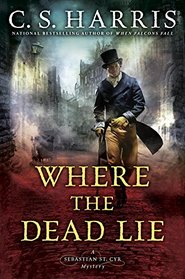Brad W. (bewilbered) reviewed Where the Dead Lie (Sebastian St. Cyr, Bk 12) on + 36 more book reviews
I've read all the books in this series and I don't think this one will stay in the memory too long compared to earlier ones. I wasn't nuts about the serial-killer/depravity story line; it offered little in terms of motive and deduction. And series regulars, even ones as major as Hero, seemed to have very perfunctory, colorless presence in the story. Only one event seems like it will have important carry-over into the next novel in terms of the ongoing mythos. Meh.
R E K. (bigstone) - , reviewed Where the Dead Lie (Sebastian St. Cyr, Bk 12) on + 1458 more book reviews
Sebastian St. Cyr, Viscount Devlin, and his former comrade in arms, surgeon Paul Gibson, have seen much violent death both in wartime and in London where they seek the killers who inhabit their city. But the body of Benji Thatcher, a street urchin who was cut, whipped, raped repeatedly, and finally strangled is beyond their experiences. Who would victimize children? But Benji is the first of many children so killed.
The victims live on the streets of London as best they can, begging, stealing, doing odd jobs and searching for food and shelter. The dead have no one to search for them, love them, or care what happens to them. When they go missing, only those who befriend them on the streets realize they are gone but their own problems far outweigh any worry about what might have happened to the missing. And, as the mystery unfolds, Sebastion discovers that victims are selected by one of their own. As he becomes emeshed in investigating the murder, Hero, his wife is researching and interviewing children for an article to publicize the plight of these abandoned young people.
As body after body is discovered, Sebastion begins finding notes directed specifically to him by the killer who is taunting him for his efforts. Finally, his tiger, Tom, is kidnapped and it is Sebastion's task to find him before he, too, becomes a victim.
Suspects are are not those normally associated with violent crime, much less the abuse and murder of children. These children have no homes, no family and few friends. For those with the sexual tastes of Marquis de Sade, who wrote a book about sadistic sexual behavior sets Sebastian in a very surprising and shocking direction. He is appalled when he finds that one of the suspects is engaged to his young, lovely niece. The man enjoys depraved sexual activities including whipping and cutting. What will this mean for the woman who marries him?
The victims live on the streets of London as best they can, begging, stealing, doing odd jobs and searching for food and shelter. The dead have no one to search for them, love them, or care what happens to them. When they go missing, only those who befriend them on the streets realize they are gone but their own problems far outweigh any worry about what might have happened to the missing. And, as the mystery unfolds, Sebastion discovers that victims are selected by one of their own. As he becomes emeshed in investigating the murder, Hero, his wife is researching and interviewing children for an article to publicize the plight of these abandoned young people.
As body after body is discovered, Sebastion begins finding notes directed specifically to him by the killer who is taunting him for his efforts. Finally, his tiger, Tom, is kidnapped and it is Sebastion's task to find him before he, too, becomes a victim.
Suspects are are not those normally associated with violent crime, much less the abuse and murder of children. These children have no homes, no family and few friends. For those with the sexual tastes of Marquis de Sade, who wrote a book about sadistic sexual behavior sets Sebastian in a very surprising and shocking direction. He is appalled when he finds that one of the suspects is engaged to his young, lovely niece. The man enjoys depraved sexual activities including whipping and cutting. What will this mean for the woman who marries him?




